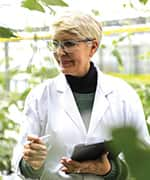LIFE EXTENSION MAGAZINE
We are surrounded by environmental toxins.
Currently, there are more than 80,000 chemicals registered or listed under the Toxic Substance Control Act.1
In 2020, approximately three billion pounds of these toxic chemicals—many known carcinogens—were released into the environment.2
More disturbing is the fact that most of these chemicals were never adequately tested by any government agency regarding their effects on human health.3
Studies now show that these chemicals can contribute to diabetes, heart disease, and cancer by causing mutations to our DNA.4-8
You can’t avoid exposure to these toxins, but you can take steps to minimize their harmful impact on your body.
An inexpensive compound called chlorophyllin helps detoxify these deadly chemicals from your body, while offering critical protection for your DNA.
Protection Against Numerous Types of Cancer
Chlorophyllin is a water-soluble derivative of the green plant substance chlorophyll.
Life Extension® reported on the antimutagenic properties of chlorophyllin in the mid-1980s. Since then, numerous studies have been published showing chlorophyllin’s ability to protect against multiple types of cancer.
The liver is especially at risk because its job is to cleanse the body of these harmful toxins.
Out of the 600,000 new cases of liver cancer diagnosed yearly, it is estimated that up to 28% of them are caused by aflatoxin, which is found in multiple improperly stored foods, including peanuts, corn, pistachios, and rice.9
Chlorophyllin binds to the carcinogenic byproducts of aflatoxin metabolism, which decreases the bioavailability of these cancer-causing chemicals.10,11
In this way, chlorophyllin has the potential to significantly reduce the risk of liver cancer induced by aflatoxin.
Additionally, chlorophyllin has been shown to protect against the following:
- Oral Cancer: A study in hamsters showed that chlorophyllin can prevent genetic mutations and reverse gene expression linked to oral cancer caused by the chemical dimethylbenzanthracene (DMBA).7,12
- Pancreatic Cancer: Chlorophyllin has antiproliferative effects on pancreatic cells.13
- Colon Cancer: When colon cancer cells were treated with chlorophyllin, it inhibited the enzyme ribonucleotide reductase (RR), which made these cancer cells less able to grow and more receptive to mainstream cancer chemotherapeutic agents.14
- Bladder Cancer: The combination of chlorophyllin with photodynamic therapy resulted in approximately 85% destruction of bladder cancer cells.15
- Breast Cancer: When human breast cells were exposed to the carcinogen dibenzopyrene (DBP), dangerous and unstable DNA adducts were formed. However, adding chlorophyllin to the breast cells led to a 65% decrease in the number of DNA adducts.16 Formation of DNA adducts is an early step in the formation of cancer-causing DNA mutations.17
- Stomach Cancer: Chlorophyllin has been shown to help stop the growth and metastasis of stomach cancer in rats.18
Anticarcinogenic Pathways
Chlorophyllin protects against many types of cancer because it targets multiple pathways involved in cancer development.
This compound, associated with healthy green plants, has demonstrated anticarcinogenic effects against a variety of widespread environmental toxins.19
- Chlorophyllin helps prevent carcinogens such as heterocyclic amines from altering DNA to inflict malignant changes.20
- It limits the formation of DNA adducts caused by known carcinogens, including dibenzanthracene, dibenzopyrene and benzophenanthrene.21
- It functions as an antimutagenic agent against chemicals such as PhlP, which are known to be involved in colon, prostate, pancreatic, and breast cancer.21,22
- It protects against mutations of the p53 tumor suppressor gene. Protecting healthy expression of p53 is a critical factor that helps guard against cancerous changes.23
Proper use of chlorophyllin affords considerable defense against the natural and man-made toxins that permeate our food and environment.
Health-conscious individuals sometimes take around 100 mg of chlorophyllin with heavy meals to protect DNA from environmental and dietary mutagens.
If you have any questions on the scientific content of this article, please call a Life Extension Wellness Specialist at 1-866-864-3027.
References
- Available at: https://www.epa.gov/sciencematters/science-matters-articles-related-safer-chemicals-research. Accessed June 3, 2022.
- Available at: https://www.epa.gov/trinationalanalysis/releases-chemicals. Accessed June 3, 2022.
- Thornton JW, McCally M, Houlihan J. Biomonitoring of industrial pollutants: health and policy implications of the chemical body burden. Public Health Rep. 2002 Jul-Aug;117(4):315-23.
- Lee HK. Mitochondrial dysfunction and insulin resistance: the contribution of dioxin-like substances. Diabetes Metab J. 2011 Jun;35(3):207-15.
- Jia G, Aroor AR, Martinez-Lemus LA, et al. Mitochondrial functional impairment in response to environmental toxins in the cardiorenal metabolic syndrome. Arch Toxicol. 2015 Feb;89(2):147-53.
- Lim S, Cho YM, Park KS, et al. Persistent organic pollutants, mitochondrial dysfunction, and metabolic syndrome. Ann N Y Acad Sci. 2010 Jul;1201:166-76.
- Auger C, Alhasawi A, Contavadoo M, et al. Dysfunctional mitochondrial bioenergetics and the pathogenesis of hepatic disorders. Front Cell Dev Biol. 2015;3:40.
- Fosslien E. Cancer morphogenesis: role of mitochondrial failure. Ann Clin Lab Sci. 2008 Autumn;38(4):307-29.
- Available at: https://www.ncbi.nlm.nih.gov/pubmed/. Accessed June 3, 2022.
- Jubert C, Mata J, Bench G, et al. Effects of chlorophyll and chlorophyllin on low-dose aflatoxin B(1) pharmacokinetics in human volunteers. Cancer Prev Res (Phila). 2009 Dec;2(12):1015-22.
- Egner PA, Wang JB, Zhu YR, et al. Chlorophyllin intervention reduces aflatoxin-DNA adducts in individuals at high risk for liver cancer. Proc Natl Acad Sci U S A. 2001 Dec 4;98(25):14601-6.
- Vidya Priyadarsini R, Kumar N, Khan I, et al. Gene expression signature of DMBA-induced hamster buccal pouch carcinomas: modulation by chlorophyllin and ellagic acid. PLoS One. 2012;7(4):e34628.
- Konickova R, Vankova K, Vanikova J, et al. Anti-cancer effects of blue-green alga Spirulina platensis, a natural source of bilirubin-like tetrapyrrolic compounds. Ann Hepatol. 2014 Mar-Apr;13(2):273-83.
- Chimploy K, Diaz GD, Li Q, et al. E2F4 and ribonucleotide reductase mediate S-phase arrest in colon cancer cells treated with chlorophyllin. Int J Cancer. 2009 Nov 1;125(9):2086-94.
- Lihuan D, Jingcun Z, Ning J, et al. Photodynamic therapy with the novel photosensitizer chlorophyllin f induces apoptosis and autophagy in human bladder cancer cells. Lasers Surg Med. 2014 Apr;46(4):319-34.
- Smith WA, Freeman JW, Gupta RC. Effect of chemopreventive agents on DNA adduction induced by the potent mammary carcinogen dibenzo[a,l]pyrene in the human breast cells MCF-7. Mutat Res. 2001 Sep 1;480-481:97-108.
- Hwa Yun B, Guo J, Bellamri M, et al. DNA adducts: Formation, biological effects, and new biospecimens for mass spectrometric measurements in humans. Mass Spectrom Rev. 2020 Mar;39(1-2):55-82.
- Thiyagarajan P, Kavitha K, Thautam A, et al. Dietary chlorophyllin abrogates TGFbeta signaling to modulate the hallmark capabilities of cancer in an animal model of forestomach carcinogenesis. Tumour Biol. 2014 Jul;35(7):6725-37.
- Nagini S, Palitti F, Natarajan AT. Chemopreventive potential of chlorophyllin: a review of the mechanisms of action and molecular targets. Nutr Cancer. 2015;67(2):203-11.
- Hayatsu H. Complex formation of heterocyclic amines with porphyrins: its use in detection and prevention. Princess Takamatsu Symp. 1995;23:172-80.
- Mata JE, Yu Z, Gray JE, et al. Effects of chlorophyllin on transport of dibenzo(a, l)pyrene, 2-amino-1-methyl-6-phenylimidazo-[4,5-b]pyridine, and aflatoxin B(1) across Caco-2 cell monolayers. Toxicology. 2004 Mar 1;196(1-2):117-25.
- Hirose M, Nishikawa A, Shibutani M, et al. Chemoprevention of heterocyclic amine-induced mammary carcinogenesis in rats. Environ Mol Mutagen. 2002;39(2-3):271-8.
- Gouda EM, Elbehairy AM, Ghoneim MA. Antimutagenic efficacy of some natural compounds on cyclophosphamide-induced p53 alterations. Z Naturforsch C J Biosci. 2008 Nov-Dec;63(11-12):857-63.



